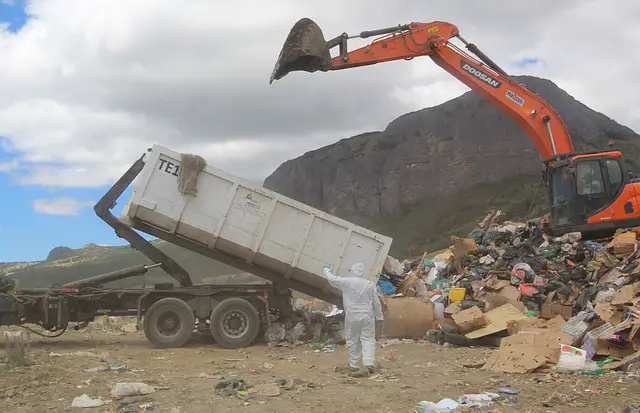In the guide below, we list and explain the categories and types of landfills.
We discuss the waste different landfills accept, along with different waste management methods at landfill sites.
We also briefly explain the potential difference between dumps and landfills.
Landfills vs Dumps – What’s The Difference?
Some reports use the phrases ‘dump’ and ‘landfill’ to refer to the same thing i.e. a space where waste is dumped or disposed of.
However, other reports are more technical and explain that there are key differences between dumps and landfills.
The main difference between landfills and dumps might be that:
– Dumps
Tend to be open spaces of land where waste is dumped without any, or much organisation or regulation
Some dumps in some countries may be open dumping sites where waste can leak into the environment
– Landfills
Tend to be more organized waste disposal sites that have guidelines and regulations for managing the waste there
Landfills may also be specially engineered to minimize environmental impact or manage waste in a specific way
nrcs.usda.gov also mentions that ‘sanitary landfills’ are not an open dump, and they prioritize human health and safety by keeping hazards in landfills away from the general public
Landfills are generally provided as a more advanced waste management service, that may engage in a range of waste management methods such as compacting waste, burying waste, using a soil liner, using a leachate management system, capturing methane gas, and so on
Landfills in countries with developed waste management systems tend to be closed off and secure (preventing waste from leaking into the environment)
Types Of Landfills
There can be various ways to categorise the different types of landfill.
For example, landfills might be categorized by:
– The type of waste the landfill accepts
– The different ‘cells’ and layout at the landfill site
– The method of waste management at the landfill site
We explain each of these points below.
Different Landfills Accept Different Types Of Waste
Different Types Of Waste
Some of the different types of landfill sites, and the types of waste they might allow include but aren’t limited to:
– Municipal solid waste landfill sites: allows municipal waste
– Commercial and industrial waste landfill sites: allows commercial and industrial waste
– Special waste landfill sites: allow toxic waste, hazardous waste, and other types of potentially unsafe waste, or waste that needs specific types of waste management. Asbestos might be an example of a hazardous waste material
– There are also some C&D dedicated landfill sites that just accept construction and demolition waste
Licenses For Different Types Of Waste
The waste types a landfill site accepts can depend on the license the site holds (in addition to the practical capability of the site to manage different types of waste)
Licenses and approval for accepting different types of waste can differ between countries (which have different regulations.
Most Common Types Of Waste Found In Landfills
We put together a guide summarising some of the most common types of waste found in different types of landfills (mostly municipal waste landfills though).
Different Landfills Have Different ‘Cells’ & Layouts
Landfill Cells
Landfill sites can have different waste cells, which are engineered, regulated and contained pits that hold different types of waste.
Cells might be designed to keep compatible waste types together, maximise compaction and minimise environmental impact.
In the standard municipal solid waste landfill site, the different waste cells might include a putrescible waste cell (for organic waste that can be broken down with microorgnisms), a solid municipal waste cell, and sometimes a commercial/industrial waste cell.
However, different landfill sites contain different cells for different waste.
Landfill Layouts & Design
Different landfill sites may also have different layouts and design in terms of where pits are located, the number of pits, open areas of waste, the equipment and technology on the site, and more.
Different Landfilling Methods
There can also be different landfilling methods that take into account the ground/land at a landfill site.
Both nrcs.usda.gov and getwaste.info discuss these different landfilling methods, so you can refer to these sources for more information on the methods.
A paraphrased summary of them might include:
– Area Method/Area Landfilling
Generally for flat or gently sloping areas
Is a method for above ground landfilling
– Trench Method/Trench Landfilling
A method where land is excavated for below ground landfilling
Generally, the water table shouldn’t be near the surface of the ground to use this landfilling method
– Ramp Or Slope Method/Ramp Or Slope Landfilling
A method that involves spreading waste along existing hills or slopes
Potential Pros & Cons Of Landfills
We list some of the potential pros and cons of landfills in this guide.
Sources
1. Various ‘Better Meets Reality’ guides
2. https://www.getwaste.info/landfilling-methods-for-urban-waste-disposal/
3. https://www.nrcs.usda.gov/wps/portal/nrcs/detail/ks/people/employees/?cid=nrcs142p2_033385#:~:text=There%20are%20three%20general%20methods,some%20land%20depressions%20may%20exist.
','' ); } ?>